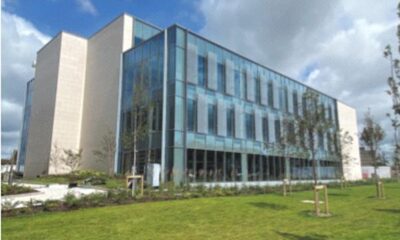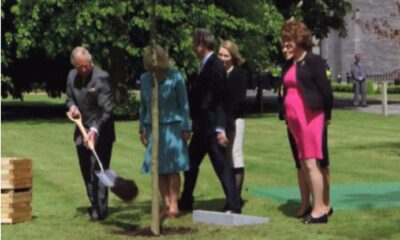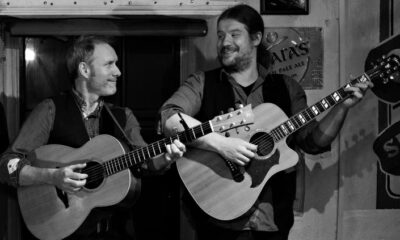News
Garda tells of horror attack by two pit bulls

A savage attack by two pit bull terriers on a Garda conducting a drugs search at a house in the Claddagh during the summer of 2008 was recalled again last week at a High Court hearing in Dublin.
Uniformed officers and members of the Garda Drugs Unit had been engaged in a heroin search on the house at St Dominick’s Road, when they were savagely attacked by the pit bull terriers.
One of the Gardaí involved in the search – Detective Garda John Leahy – suffered horrific cuts and a gash to his leg in the attack, and is bringing a claim for compensation against the State in relation to the incident.
The proceedings date back to the night of June 26, 2008, when a Garda search party entered the house in the Claddagh that had seven people inside at the time.
During the course of a struggle that ensued during the course of the search, three dogs were ‘released’ from another room in the house with two of the pit bulls ripping into the trousers of Det Gda Leahy and the flesh of his leg.
Det Gda Leahy’s colleagues eventually managed to pull the dogs off him, but he had to be rushed to University Hospital Galway where emergency medical treatment had to be administered.
One of the wounds required 100 stitches and had left Det Gda Leahy’s leg with multiple scars, the Garda Compensation Hearing at the High Court was told this week.
One man present on the night of the search was subsequently convicted of impeding a member of the Gardaí by putting drugs in his mouth and for resisting attempts by Gardaí to prevent him from swallowing the substance.
John Tompkins (39) with an address at Ard Alainn, Ballybane, was sentenced to 17 months imprisonment by Judge Aeneas McCarthy following his conviction. The court heard that Tompkins had 16 previous convictions.
At the time of the incident, city councillor Terry O’Flaherty called for the putting in place of a total ban on dangerous and aggressive dog breeds.
“It appears to me that someone will have to be maimed – or worse still, killed – in this country, before any action will be taken to ban those highly dangerous breed of dogs,” Cllr O’Flaherty said at the time.
A colleague of Det Gda Leahy, Garda Orla Keenan, who was involved in the search of the house that night, told this week’s High Court hearing that it was one of the worst experiences of her life.
She described how the dogs had “ripped open” Det Gda Leahy’s leg with “blood everywhere” – Gda Keenan broke down as she gave her evidence before Mr Justice Bernard Barton.
The incident on the Thursday night of June 26, 2008, began when both Det Gda Leahy and Gda Keenan noticed a known heroin addict and another man acting in a suspicious manner in the Spanish Arch area at around 10.45pm.
Later, the men were seen entering the house at St Dominick’s Road, leading to a full search of the house that night by Gardai, during which the dog attack occurred. Seven men in the house were arrested at the time.
During the course of the search, according to Garda evidence at a subsequent court case, one of the occupants of the housed swallowed a package suspected of containing heroin.
When the man was challenged about what he had swallowed, Det Gda Leahy later recalled in court evidence, that the name ‘bull’ was called out, at which point the dogs were released from the room.
The dog attack lasted about 15 to 20 minutes, according to the resultant court case, with one of the pit bulls only being released after being ‘semi-choked’ by one of the Gardai.
Two dogs were later seized by Gardaí with the help of the city’s dog warden and put down – in a follow-up search of the house after the initial incident, the dogs also attempted to attack the Gardaí.
During this week’s High Court compensation hearing, Det Gda Leahy outlined the extent of the injuries that he had suffered in the attack and its subsequent impact on him.
He said that the attack had exacerbated a degenerative condition in his back, had caused hip pain and had left his leg badly scarred.
Mr Justice Barton reserved his judgment in the case to a later date.
Connacht Tribune
West has lower cancer survival rates than rest

Significant state investment is required to address ‘shocking’ inequalities that leave cancer patients in the West at greater risk of succumbing to the disease.
A meeting of Regional Health Forum West heard that survival rates for breast, lung and colorectal cancers than the national average, and with the most deprived quintile of the population, the West’s residents faced poorer outcomes from a cancer diagnosis.
For breast cancer patients, the five-year survival rate was 80% in the West versus 85% nationally; for lung cancer patients it was 16.7% in the west against a 19.5% national survival rate; and in the West’s colorectal cancer patients, there was a 62.6% survival rate where the national average was 63.1%.
These startling statistics were provided in answer to a question from Ballinasloe-based Cllr Evelyn Parsons (Ind) who said it was yet another reminder that cancer treatment infrastructure in the West was in dire need of improvement.
“The situation is pretty stark. In the Western Regional Health Forum area, we have the highest incidence of deprivation and the highest health inequalities because of that – we have the highest incidences of cancer nationally because of that,” said Cllr Parsons, who is also a general practitioner.
In details provided by CEO of Saolta Health Care Group, which operates Galway’s hospitals, it was stated that a number of factors were impacting on patient outcomes.
Get the full story in this week’s Connacht Tribune, on sale in shops now, or you can download the digital edition from www.connachttribune.ie. You can also download our Connacht Tribune App from Apple’s App Store or get the Android Version from Google Play.
Connacht Tribune
Marathon Man plans to call a halt – but not before he hits 160 races
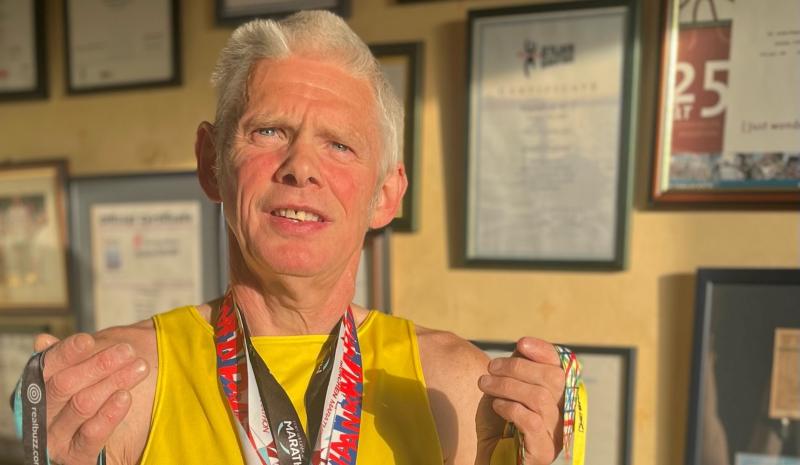
On the eve of completing his 150th marathon, an odyssey that has taken him across 53 countries, Loughrea’s Marathon Man has announced that he is planning to hang up his running shoes.
But not before Jarlath Fitzgerald completes another ten races, making it 160 marathons on the occasion of his 60th birthday.
“I want to draw the line in 2026. I turn 57 in October and when I reach 60 it’s the finishing line. The longer races are taking it out of me. I did 20 miles there two weeks ago and didn’t feel good. It’s getting harder,” he reveals.
“I’ve arthritis in both hips and there’s wear and tear in the knees.”
We speak as he is about to head out for a run before his shift in Supervalu Loughrea. Despite his physical complaints, he still clocks up 30 miles every second week and generally runs four days a week.
Jarlath receives injections to his left hip to keep the pain at bay while running on the road.
To give his joints a break, during the winter he runs cross country and often does a five-mile trek around Kylebrack Wood.
He is planning on running his 150th marathon in Cork on June 4, where a group of 20 made up of work colleagues, friends and running mates from Loughrea Athletics Club will join him.
Some are doing the 10k, others are doing the half marathon, but all will be there on the finishing line to cheer him on in the phenomenal achievement.
Get the full story in this week’s Connacht Tribune, on sale in shops now, or you can download the digital edition from www.connachttribune.ie. You can also download our Connacht Tribune App from Apple’s App Store or get the Android Version from Google Play.
CITY TRIBUNE
Galway ‘masterplan’ needed to tackle housing and transport crises
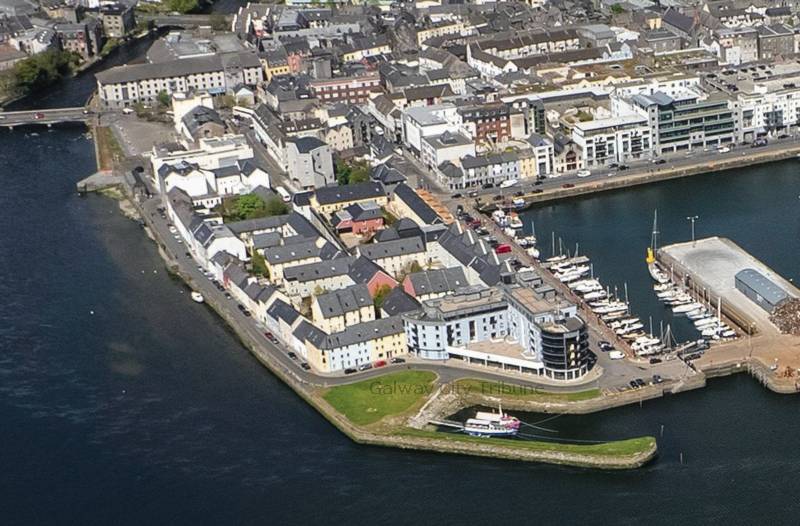
From the Galway City Tribune – An impassioned plea for a ‘masterplan’ that would guide Galway City into the future has been made in the Dáil. Galway West TD Catherine Connolly stated this week that there needed to be an all-inclusive approach with “vision and leadership” in order to build a sustainable city.
Deputy Connolly spoke at length at the crisis surrounding traffic and housing in Galway city and said that not all of the blame could be laid at the door of the local authority.
She said that her preference would be the provision of light rail as the main form of public transport, but that this would have to be driven by the government.
“I sat on the local council for 17 years and despaired at all of the solutions going down one road, metaphorically and literally. In 2005 we put Park & Ride into the development plan, but that has not been rolled out. A 2016 transport strategy was outdated at the time and still has not been updated.
“Due to the housing crisis in the city, a task force was set up in 2019. Not a single report or analysis has been published on the cause of the crisis,” added Deputy Connolly.
She then referred to a report from the Land Development Agency (LDA) that identified lands suitable for the provision of housing. But she said that two-thirds of these had significant problems and a large portion was in Merlin Park University Hospital which, she said, would never have housing built on it.
In response, Minister Simon Harris spoke of the continuing job investment in the city and also in higher education, which is his portfolio.
But turning his attention to traffic congestion, he accepted that there were “real issues” when it came to transport, mobility and accessibility around Galway.
“We share the view that we need a Park & Ride facility and I understand there are also Bus Connects plans.
“I also suggest that the City Council reflect on her comments. I am proud to be in a Government that is providing unparalleled levels of investment to local authorities and unparalleled opportunities for local authorities to draw down,” he said.
Then Minister Harris referred to the controversial Galway City Outer Ring Road which he said was “struck down by An Bord Pleanála”, despite a lot of energy having been put into that project.
However, Deputy Connolly picked up on this and pointed out that An Bord Pleanála did not say ‘No’ to the ring road.
“The High Court said ‘No’ to the ring road because An Bord Pleanála acknowledged it failed utterly to consider climate change and our climate change obligations.
“That tells us something about An Bord Pleanála and the management that submitted such a plan.”
In the end, Minister Harris agreed that there needed to be a masterplan for Galway City.
“I suggest it is for the local authority to come up with a vision and then work with the Government to try to fund and implement that.”


